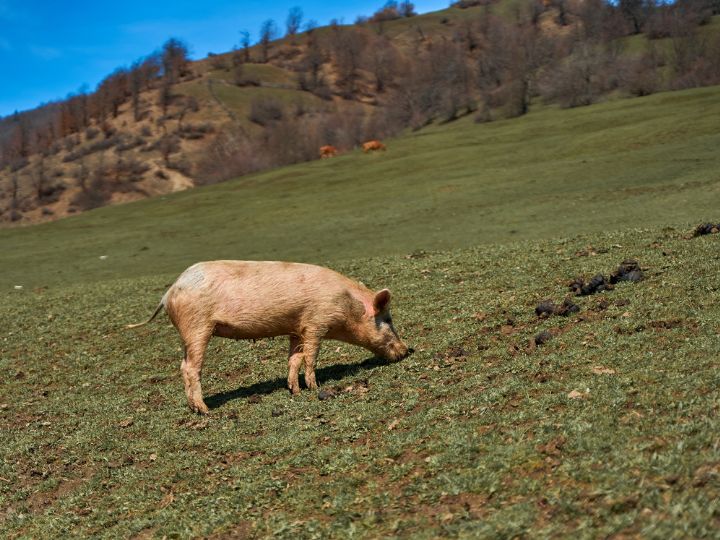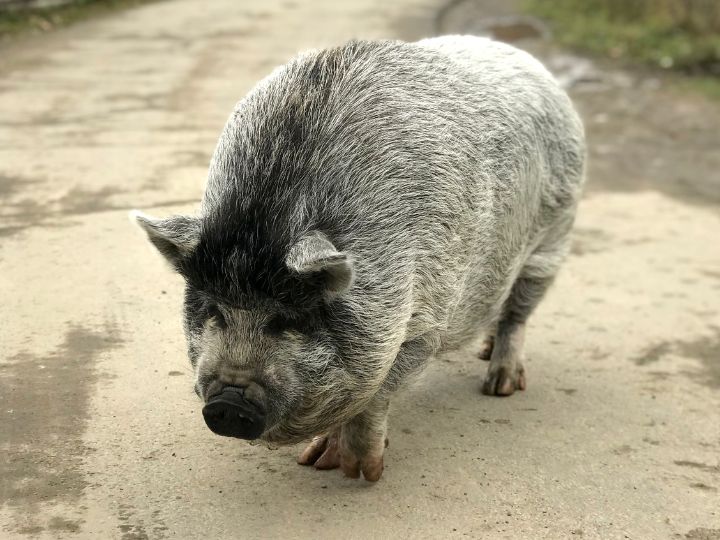Have you ever wondered if pigs can walk backward? This simple question might spark curiosity in many animal lovers and spark a fascinating discussion about the locomotion of these intelligent creatures. Pigs, like most mammals, are equipped with four legs, allowing them a range of motion to navigate their environment including backwards. In this article, we will explore the ability of pigs to walk backwards and the circumstances that motivate them to do so.
Pigs are generally shy creatures, avoiding confrontation and aggression when possible. Their ability to move in various directions, including backward, is an essential aspect of their adaptability. This skill helps pigs escape tight spaces and navigate challenging situations in their surroundings. However, walking in backward motion is not a pig’s first choice for movement, as it tends to occur only when they are frightened or startled.
Now that we understand pigs have the ability to move both forward and backward, we can delve deeper into the topic and analyze the reasons and other factors that contribute to their versatile movement skills. Stay tuned to learn more about these amazing animals and their locomotion capabilities.
Pigs’ Physical Attributes and Walking Mechanics
Pig Anatomy and Movement
Pigs are intelligent, social animals with unique physical features that influence their movement. Their skeletal systems are adapted for agility and support. Pigs have a spine that curves downward, contributing to their low center of gravity. This allows them to maintain their balance while moving. Pigs have four legs, each with four toes, two of which support their body weight. Their limbs are strong, allowing for smooth, fluid locomotion.
Pigs primarily walk with a four-beat gait, with their forelimbs carrying more load, receiving higher peak vertical forces, and having longer-lasting stance phases than their hindlimbs. This biomechanical adaptation enables them to navigate on various terrains, including solid concrete floors.
Pigs’ Ability to Walk Backwards
Pigs can walk backward, although they may not do so as frequently or as dexterously as other animals. This capability provides them with the flexibility to navigate various terrains and situations. Walking backward can be advantageous for pigs when they need to back out of tight spaces, such as in a crowded pen or while foraging for food. Moreover, walking backward can help them escape predators or protect their offspring from threats.
However, walking backward can also compromise a pig’s point of balance. The natural curvature of their spine and their low center of gravity may make it challenging to maintain stability while walking in reverse. Additionally, body temperature can influence a pig’s movement, as they are sensitive to heat and may become less agile and unwilling to move in high-temperature environments.
Comparing Pigs’ Walking Abilities to Other Animals
Flightless Birds and Pigs’ Walking Mechanics
Certain flightless birds, such as emus and penguins, have unique walking abilities that distinguish them from pigs. While pigs can walk forwards, they are also able to walk backward, albeit with slightly less agility due to their body structure. On the other hand, emus are unable to walk backward due to the orientation of their leg joints and the construction of their pelvic muscles. Penguins, while capable of walking backward in short distances, primarily rely on walking forwards and using their webbed feet for swimming, making their movements inherently different from those of pigs.

Mammals Sharing Similar Walking Limitations
Aside from flightless birds, other mammals share walking limitations with pigs, including:
- Cows and sheep: Both animals have a similar walking mechanic to pigs, with the ability to walk backwards but generally preferring to move forward due to their body structure.
- Kangaroos: These marsupials primarily rely on hopping for movement and are known to hop backward occasionally, although it is less common and agile compared to their forward hopping.
- Horses: Horses can walk backward, but it is less natural for them and typically requires training. They usually opt for forward movement, similar to pigs.
- Dogs: While dogs can walk backward, they primarily move forward and rely on their more agile limbs for complex and coordinated movements.
- Platypus: As semi-aquatic mammals, platypus has evolved walking mechanics that favor both land and water, but like pigs, they primarily move forward and can walk backward if necessary.
Unique Walking Abilities of Animals
There are also animals with unique walking abilities that set them apart from pigs and many other mammals:
- Alligators: These reptiles have the ability to high walk, a form of terrestrial locomotion where the alligator lifts its entire body off the ground while moving forward, backward, or turning.

In conclusion, pigs can walk backward but usually prefer to move forward. Comparing pigs to other animals, it is evident that various species exhibit different walking mechanics or limitations, reflecting their evolutionary adaptations and habitat requirements.
Pig Care and Safety Considerations
How to Safely Manage Pigs’ Mobility Limitations
Pigs, like cows and horses, have mobility limitations. However, unlike these other animals, pigs have a unique way of moving about, Waddling. Waddling is different from the high walk of alligators or the saltation of spring-based creatures. Pigs can move forward with ease but have difficulty walking backward due to their anatomy and calf muscle structure. To ensure the safe management of pigs’ mobility limitations, it’s essential to provide appropriate care and infrastructure.
One way to facilitate the movement of pigs is by installing ramps that allow them to move between different levels easily. These ramps can make navigating their environment more accessible and can reduce the potential for injury. It is also vital to use level, non-slip flooring in areas where pigs are kept to minimize the risk of slips and falls.
Signs of Stress and Fear in Pigs
Pigs have a highly developed sense of smell, akin to dogs and elephants. This keen sense helps them detect potential threats, such as predators like lions. As a result, they are sensitive to changes in their environment and can experience stress or fear when exposed to unfamiliar situations or perceived dangers.
Signs of stress in pigs can include:
- Aggressive behavior: This may manifest as snapping, biting, or charging towards other animals or people.
- Vocalizations: Pigs may make loud, high-pitched calls or grunts when they are scared.
- Rapid breathing or panting: If a pig is experiencing stress, its breathing may become quicker or shallower.
- Restlessness or pacing: Like a horse, pigs may pace back and forth or become agitated when they are stressed.
To minimize stress in pigs, provide a calm, consistent environment and handle them with care. Offer sensory enrichment, such as toys or varied terrain, to stimulate their senses and alleviate stress.
By being mindful of pigs’ mobility limitations, providing appropriate adaptations, and understanding the signs of stress or fear, caregivers can ensure the well-being and safe management of these unique animals.
Interesting Facts and Exceptions
Other Animals With Unique Walking Abilities
Apart from pigs, which can indeed walk backwards, there are several other animals with unique walking abilities. Some animals, such as rhinos, have difficulty walking backwards due to their large size and joint structure. Stick bugs, on the other hand, can walk backwards but typically prefer to do so only when necessary. Crab spiders possess a fascinating ability to walk sideways, which helps them navigate their environment efficiently. Cats, too, can walk backward; however, they usually prefer to go forward or sideways, especially when stalking prey.
The Role of Walking Backward in Animal Adaptation
Walking backward plays an essential role in animal adaptation. For many animals, the ability to walk backward helps them escape predators, navigate their surroundings more effectively, and even reduce stress in some situations. In the case of animals that can’t walk backward, like the emu, their physical structures have evolved to prioritize other forms of movement that are more beneficial to their survival and adaptation in their specific environment.
Another aspect to consider is that some animals may experience pain or discomfort when walking backward, leading them to avoid such movements. Similarly, animals rely on their senses, such as hearing, to navigate their surroundings and may prioritize forward over backward movement due to their sense of direction and spatial awareness for safety reasons.
In conclusion, while pigs can walk backward, other animals have unique walking abilities that reflect their adaptations to their environment and survival strategies. These different walking abilities often reduce stress, help with navigation, or protect the animal from dangerous situations.
Conclusion and Additional Resources
In summary, pigs possess the ability to walk backwards. This fact can be fascinating, especially for those who have personal experiences observing pigs at farms or other settings. The bottom line is that pigs, like many other animals, are capable of demonstrating a wide range of movement and behaviors.
For further information and resources on pigs and their behavior, one may refer to sources like the Pork Information Gateway, which provides valuable insight into how to handle pigs, and Animal Restraint Swine by CFSPH, which delves into swine handling techniques for their well-being. These references can enhance one’s understanding of pigs and their capabilities.
Lastly, while it may not be a common sight, witnessing pigs walking backwards at a farm can certainly enrich one’s knowledge and experience with these unique creatures.
Frequently Asked Questions
Becky is a fervent wildlife enthusiast and pet care expert with a diploma in canine nutrition. Her love for animals stretches beyond the domestic, embracing the wild tapestry of global fauna. With over a decade of experience in animal welfare, Becky lends her expertise to OutlandishOwl through insightful articles, captivating wildlife information, and invaluable guidance on pet nutrition. Her work embodies a deep commitment to understanding the intricate lives of animals and a passion for educating others on sustaining natural habitats. Becky's hands-on conservation efforts and her knack for translating complex dietary science into practical pet feeding tips make her an indispensable voice for creatures great and small.




